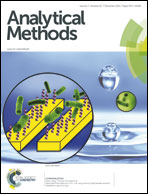Raman spectroscopy based method for the evaluation of compositional consistency of nanofibrous layers
Abstract
Electrospinning is currently a very popular method used across a number of industries. Electrospinning enables the production of nanofibrous layers of various structures and compositions. The production of a multi-component nanofibrous layer may result in an uneven distribution of the individual components throughout the layer. Confocal Raman spectroscopy combined with statistical methods allows these layers to be analysed by determining their chemical composition and thus provides feedback for the spinning process. This paper presents a method which combines Raman spectroscopy analysis and its subsequent evaluation with singular value decomposition (SVD). Automated measurement of Raman spectra makes it possible to gather extensive spectral data from a particular area selected on a sample; the spectra are measured from a specific volume and not from individual fibres. Samples require no preparation for the analysis and the non-destructive nature of Raman spectroscopy ensures their reusability. When spectra of the individual component materials are included for reference, the subsequent SVD analysis of the spectral data makes it possible to determine the chemical composition of the measured areas, thus providing the content percentages of the individual components, which can be displayed either in the form of a scattered plot or a Raman map.


 Please wait while we load your content...
Please wait while we load your content...